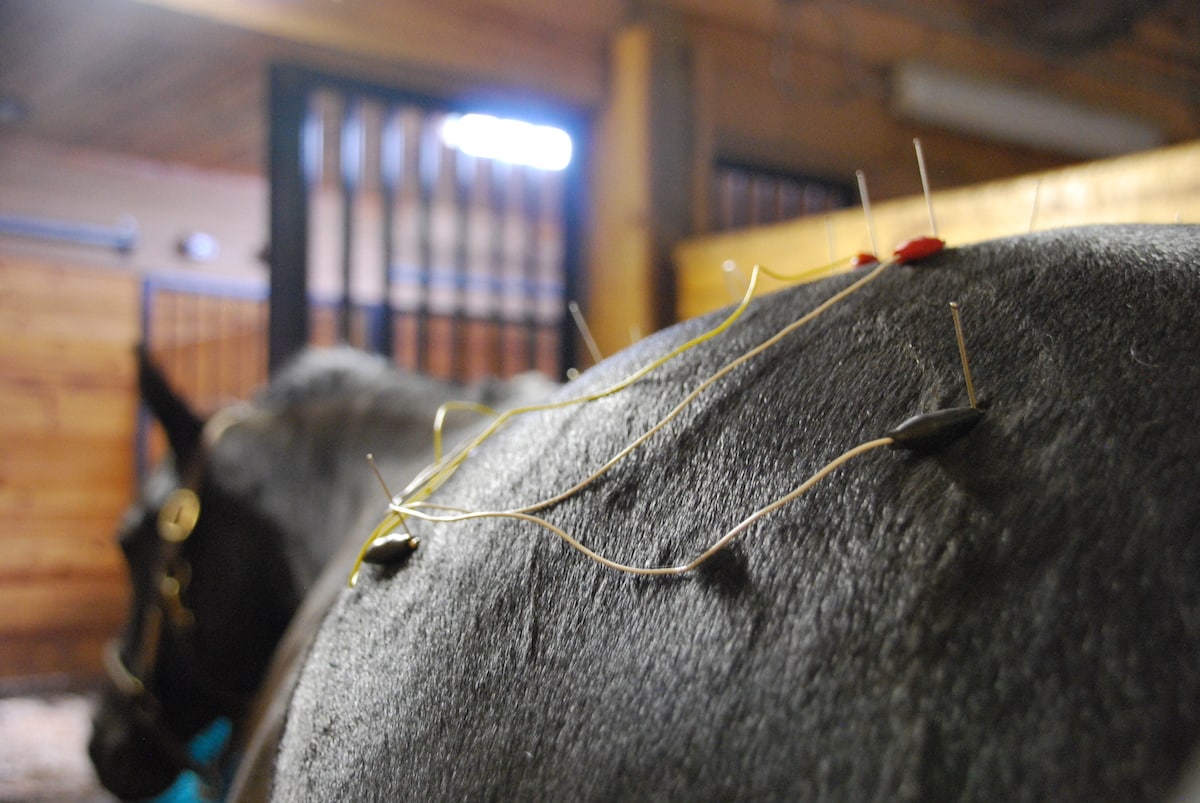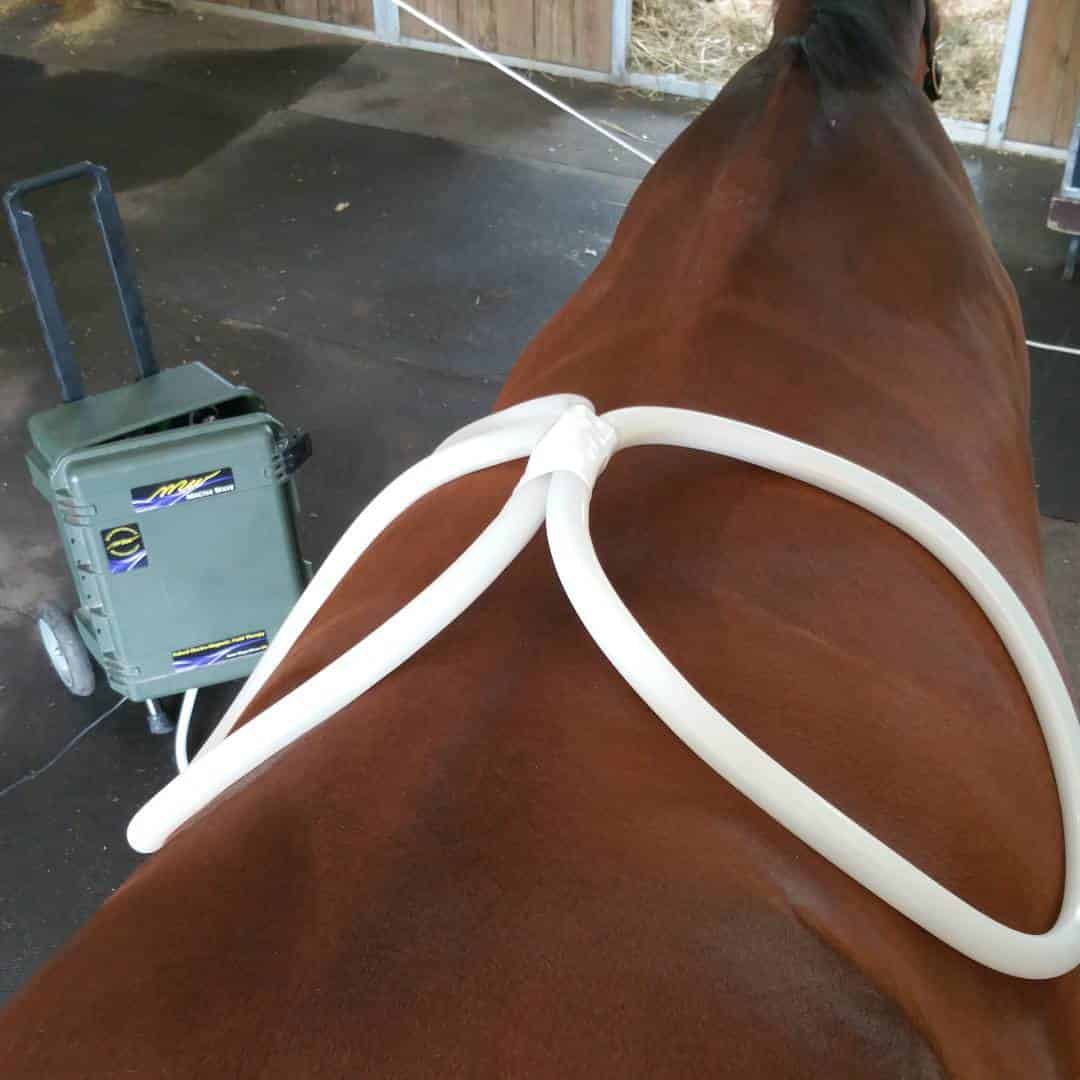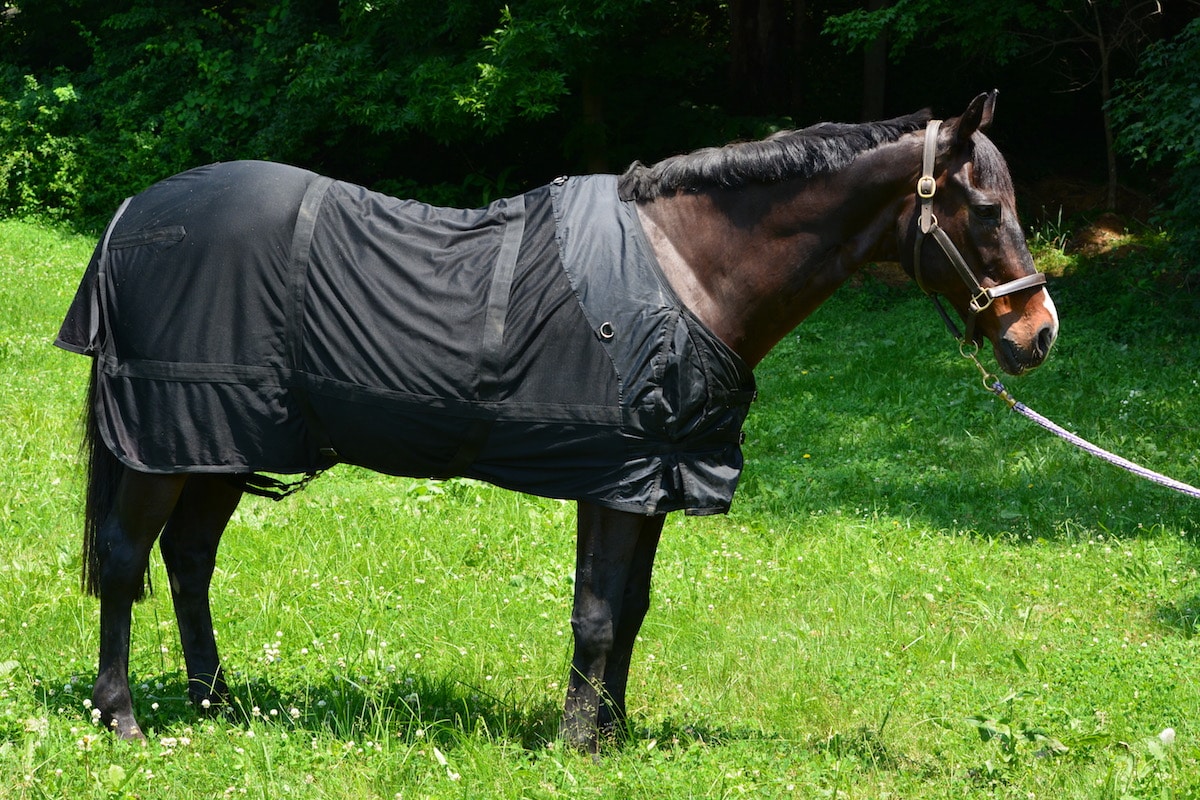
Modalities such as acupuncture might aid a horse’s healing process when used in concert with traditional veterinary medicine. Courtesy Alexandra Beckstett
Racehorses work hard — they are some of the fittest, fastest creatures out there. And like all finely tuned athletes, their bodies are subject to stress that accumulates, translating to soreness, tightness and general wear and tear, even in the absence of injury.
Many racehorses come off the track sound and fit, but their bodies, which are used to high-intensity exercise, undergo major changes when they slow down and transition into new careers. While this can take weeks, months or even years, owners and their veterinarians have at their disposal a number of therapies that can help speed the process without hindering the end result. Those therapies fall under the alternative and complementary medicine umbrella, and they’re getting more popular by the minute.
Here we’ll look at how these modalities fit into horse health care programs, what issues they can benefit and how they can help OTTBs as they transition to their second careers.
Alternative and Complementary Therapies 101
Simply put, alternative and complementary therapies are nontraditional medical techniques — such as chiropractic, acupuncture or massage — that can bolster a horse’s conventional health care or maintenance routine, says Sara Sammons, DVM, MS, cVMA, CVC (AVCA Certified), CERP, owner of Lavender Equine Rehabilitation and Veterinary Services, in Canby, Oregon.
Modalities are considered complementary when they’re used in addition to traditional medicine, says Rachel Heart Bellini, DVM, CVA, CVSMT, AVCA Certified, who owns Heart Equine, in Franktown, Colorado, and worked as a racetrack practitioner for a decade. They’re considered alternative when they’re used instead of conventional practices, she says. For example, massage, chiropractic or acupuncture might help improve a body-sore horse’s comfort level enough to eliminate the need to administer anti-inflammatory medications or muscle relaxers.
The key, Heart Bellini says, is to obtain a diagnosis first.
“You can make horses feel very, very good with complementary therapies — better than they should feel,” she says. “One of the problems I’ve run into, being primarily a complementary/alternative veterinarian, is that I’ve missed (injuries) just trying to use complementary therapies. Sometimes even just ‘sore’ horses might have an injury that actually needs conventional intervention,” such as stall rest, medication or surgery.
Alternative therapies also shouldn’t replace conventional ones for infectious illnesses, respiratory problems, hormone issues, wounds, colic and other conditions. Heart Bellini says some modalities (particularly acupuncture) might help the healing process when used in a complementary fashion. “But as Dr. Huisheng Xie, the founder of the Chi Institute (a leading education provider of traditional Chinese veterinary medicine, including acupuncture), says, ‘When you have infection, antibiotics are better,’ ” she says.
Which Horses Benefit?
Heart Bellini and Sammons agree that complementary modalities can help all horses, especially equine athletes, injured or healthy.
“I think all our athletes can benefit from supportive complementary care because they’re never perfect,” says Heart Bellini. “I think a lot of horses don’t reach their full potential because people think they’re healthy, but they’re not. They have muscle soreness, they have pain, they have issues, and people don’t even realize it. A lot of times horses will have behavioral issues, and the foundation of that is pain somewhere, but it’s not always the kind of pain we (veterinarians) are conventionally trained to look for or would have a treatment for.”
Consider, she says, a horse that regularly stands at the back of his stall.
“You wouldn’t necessarily call your vet out because your horse is standing at the back of its stall,” she says. “The vet could come out and run bloodwork and it could be normal, but the horse could have any number of problems.”
For racehorses exhibiting such behavior, Heart Bellini has tried applying magnetic bell boots to improve comfort and reduce inapparent inflammation when they were stalled.
“These horses went from standing in the back of the stall to standing at the front with their heads out,” she says. “It was obvious just from their behavior that (the boots were) making them feel better while they were standing around.”
Both veterinarians also agree that complementary and alternative therapies can significantly help OTTBs, particularly those recently off the track.
“A lot of the horses that come off the track aren’t lame, but they have a lot of musculoskeletal pain,” Heart Bellini says. “They don’t have a broken bone, they don’t have a torn tendon, they don’t have an issue that needs to be stall-rested. Conventional medicine doesn’t really have anything to offer these horses (besides anti-inflammatory drugs).”
Nonconventional modalities can help not only OTTBs’ bodies in this scenario, she says, but also their minds.
“They come off the track, and they’re like adrenaline junkies; it doesn’t take much to get them into that fight-or-flight response,” she says. “A lot of these modalities treat the parasympathetic nervous system — they help horses relax, take a deep breath and release endorphins.”
Minimizing horses’ fight-or-flight responses can help improve their trainability and help them settle into their new lives quicker, she says.
And if an OTTB was retired due to injury, complementary modalities used in conjunction with appropriate conventional veterinary therapies “promote more complete or faster healing and correct biomechanics, provide pain relief, help maintain muscle tone and condition during layup or stimulate or relax nerves or muscles,” Sammons says.
Even horses long off the track can benefit from these modalities, Heart Bellini says, citing the OTTB she rides for fun as an example.
“The barn owners have had him a couple years, and in the two months I’ve had him, just working on him once a week, the horse has changed in every aspect,” she says. “He’s changed in his herd order, he’s become more alpha, he seems to feel better in his body, his posture is different, he’s not as reactive, he’s more focused.”
Every horse is different, so work with your veterinarian and/or therapy provider to develop the ideal schedule for yours.

Electromagnetic therapy is purported to help relieve pain, reduce inflammation and improve healing time. Courtesy Magnawave
Therapeutic Options
Now, here’s where things get a little less clear-cut: Which complementary or alternative therapy is best for your horse? Well, as is the case with most things in the horse world, it depends.
There are many complementary therapy options, most of which work in different ways. We’ll review some of the most commonly used, but this list isn’t exhaustive. Discuss your horse’s needs with your practitioner, and he or she can pinpoint which modalities could have the most benefit.
Chiropractic This centers on correcting abnormal motion of each vertebra along with the effects it might be having on the surrounding tissues.
“To me, chiropractic is a foundation therapy that benefits the health of all vertebrates — anything that has a spine,” says Heart Bellini. “The alignment of the spine is the basis for a nervous system that functions at its greatest potential. Because it’s working through the nervous system, if you have a subluxation (vertebral dislocation) and the associated nerve isn’t functioning to its maximum potential, then everything it innervates is not going to function to its maximum potential.”
Sammons says chiropractic can also benefit horses with back, neck and pelvic pain, and those that have suffered trauma (such as a kick or fall). It can help horses maintain comfort during times of stress or illness, as well, she says, or afford relief to a horse that’s been wearing ill-fitting tack.
However, “chiropractic is not a substitute for properly fitting tack,” she says, “or for working up a primary lameness.”
Heart Bellini cautions that manipulating a horse’s spine manually can result in injury to the animal if the practitioner is not trained properly.
Acupuncture This traditional Chinese therapy involves placing thin needles along “meridians” in the body to influence qi (pronounced “chi”) energy and has a wide range of applications.
“You can basically treat anything you can treat with conventional medicine using acupuncture,” Heart Bellini says. “It doesn’t always work, but there are treatments for breathing problems, hormone problems, musculoskeletal problems, behavioral problems — basically there’s an acupuncture treatment for most problems, musculoskeletal as well as medical.”
In the musculoskeletal realm, Sammons says, acupuncture can help horses with muscle, nerve and joint pain or dysfunction.
She cautions that practitioners should use acupuncture carefully in anesthetized and sedated horses.
“In these cases you don’t get normal feedback from the horse, so you can do too much without realizing it,” Heart Bellini says.
Massage therapy and myofascial release While these two modalities are often lumped into one category, they focus on different parts of the horse’s body. Therapists use massage to focus on the muscles and myofascial release to target the fascia — the connective tissue beneath the skin that attaches, stabilizes, encloses and separates muscles and other internal organs. Both structures can become tight and/or injured and can benefit from manual manipulation.
Heart Bellini considers massage another foundation therapy. She says she works closely with massage therapists if she’s targeting a specific issue to monitor progress and outcomes.
Meanwhile, she says, “work in the fascia is probably the next big frontier that we’re going to be addressing.”
Sammons says both therapies can particularly help hard-working equine athletes and horses with muscle tension and/or soreness, as well as those that have suffered physical trauma.
Like chiropractic, she adds, these modalities are not replacements for a proper lameness workup or properly fitting tack.
Pulsed electromagnetic field therapy (PEMF) and extracorporeal shock wave therapy (ESWT) The theory behind PEMF is that applying a pulsating electromagnetic field of varying intensity and frequency will help relieve pain, reduce inflammation and decrease healing time.
Both Sammons and Heart Bellini say PEMF can be very useful for treating muscle, bone and nerve pain, but should be used with care because it doesn’t necessarily address the pain’s origin.
“I see a lot of, ‘My horse is sore, let’s Magna Wave him,’ ” Heart Bellini says. “But they can be missing the diagnosis.
“I think it’s very good at decreasing healing time and good for pain control, but I would really like those horses to be under the care of a veterinarian, so we know why they’re painful in the first place,” she says.
Meanwhile, ESWT involves applying high-pressure, low-frequency sound waves to an injured area of the body to promote healing. Again, Heart Bellini and Sammons agree that it is useful for pain relief and healing, but it could, in some cases, mask pain rather than treat its root cause. As such, Heart Bellini says she prefers veterinarians administer ESWT.
Used correctly, Sammons says, “it’s good for pain relief, particularly for injuries at bone-soft tissue interfaces such as the proximal suspensory ligament, splint bone and back.”
Vibration plates Our sources are big fans of vibration plates. Both cite research indicating that time on a platform can help increase paraspinal (postural) muscle mass, promote core strength and relieve back pain.
“I’m really very big on posture being the basis for a sound horse,” says Heart Bellini, and in the case of injured horses, “if you don’t have good posture it’s hard to get better.”
Sammons says vibration plates can also help horses with equine bone fragility syndrome, a condition characterized by decreased bone density and mass.
Heart Bellini cautions that some horses don’t like standing on vibration platforms, so she encourages owners to keep a close eye on their animals.
“When a horse is on a vibration plate, he should look a little sedated, like he’s getting endorphins,” she says.
If horses appear agitated she recommends reducing the vibration frequency. It’s also common practice to provide a haynet or feed to keep horses busy while standing on the platform.
Sammons says veterinarians do not recommend vibration plates for horses with injuries in which too much movement could prove detrimental, such as laminitis, neurologic disorders and fractures.
Wearable therapeutic textiles Magnetic boots and blankets, ceramic-infused or ionic fabrics, acupressure sheets — they’re all commonly used among horse owners. Both Heart Bellini and Sammons agree they can help stimulate tissues, improve circulation and reduce inflammation, potentially making horses more comfortable in the process.
“They’re not going to solve the problem,” Heart Bellini says, “but a lot of horses deal with issues that are never going to get resolved,” such as less-than-ideal conformation or general soreness.
Especially in those cases, she says, “a lot of these adjunct therapies are great.”
Sammons cautions owners to introduce these products gradually, as some horses develop swelling if they’re used too long too quickly.

Therapeutic textiles can help stimulate tissues, improve circulation and reduce inflammation. Courtesy Erica Larson
Choose Practitioners Carefully
Some complementary modalities won’t hurt your horse, even if they might not necessarily help, but others will. Therefore, choosing an appropriate practitioner is a must.
Licensing laws vary by state. For example, in some locations only veterinarians and/or doctors of (human) chiropractic with appropriate training are allowed to administer chiropractic care to horses, says Heart Bellini. And in most cases veterinarians are the only practitioners legally allowed to perform acupuncture on horses, Sammons says.
It’s always a good idea to review your state’s licensing rules to ensure potential practitioners are in line.
With less regulated therapies, such as massage or PEMF, you might have a choice between your veterinarian and a lay practitioner.
“Veterinarians have the advantage of having medical/surgical knowledge of injuries, illness and recovery,” says Sammons. “However, there are certification courses that allow other professionals to become certified in certain techniques, and they may be quite qualified.
“Also, some practitioners have a certification in equine rehabilitation,” she says, “which means they’ve been educated in multiple modalities for rehabilitation, including most, if not all, alternative/complementary modalities.”
Heart Bellini says word-of-mouth can be a powerful tool for assessing potential practitioners, as can observing them work.
“I don’t think that the horses should be anxious, panicked or put in compromising situations during treatment,” she says.
She encouraged owners to ask for an explanation if they’re unsure of what a practitioner is doing, and speak up if they’re uncomfortable with something.
Take-Home Message
Used appropriately, complementary and alternative therapies can help horses — and especially OTTBs — feel and perform better, our sources say.
“Keeping these horses balanced, sound and happy will keep them away from really expensive injuries and get the OTTBs turned around for a second career quicker,” says Heart Bellini.
This article was originally published in the Summer 2018 issue of Off-Track Thoroughbred Magazine, the only publication dedicated to the Thoroughbred ex-racehorse in second careers. Want four information-packed issues a year delivered to your door or your favorite digital device? Subscribe now!

